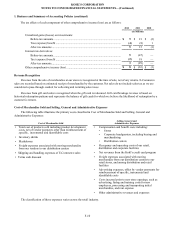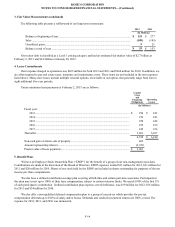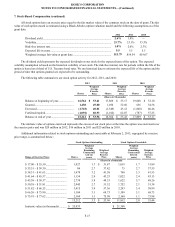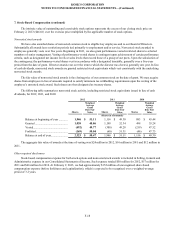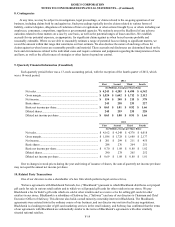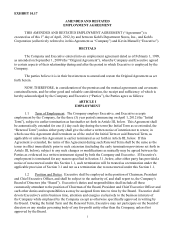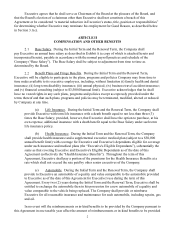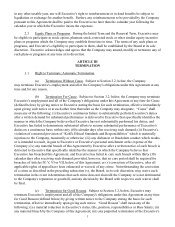Kohl's 2012 Annual Report Download - page 52
Download and view the complete annual report
Please find page 52 of the 2012 Kohl's annual report below. You can navigate through the pages in the report by either clicking on the pages listed below, or by using the keyword search tool below to find specific information within the annual report.KOHL’S CORPORATION
NOTES TO CONSOLIDATED FINANCIAL STATEMENTS—(Continued)
F-13
2. Debt (continued)
In October 2011, we issued $650 million of 4.00% notes with semi-annual interest payments beginning May 2012. The
notes mature on November 1, 2021. In anticipation of this debt issuance, we entered into interest rate hedges in December 2010
and May 2011 to hedge our exposure to the risk of increases in interest rates on $400 million of debt. In conjunction with the
debt issuance, we paid $48 million, the fair market value of the hedges, to settle the hedges. The unrealized loss on the hedges
is recognized as interest expense at a rate of $5 million per year over the ten-year life of the debt.
We have various facilities upon which we may draw funds, including a five-year, $1 billion senior unsecured revolving
credit facility which we entered into in June 2011. The credit facility includes 16 lenders which have each committed between
$30 million and $110 million. We also have a demand note with availability of $30 million. There were no draws on these
facilities during 2012 or 2011.
Our debt agreements contain various covenants including limitations on additional indebtedness and certain financial
tests. As of February 2, 2013, we were in compliance with all covenants of the debt agreements.
We also have outstanding trade letters of credit and stand-by letters of credit totaling approximately $76 million at
February 2, 2013, issued under uncommitted lines with two banks.
3. Fair Value Measurements
ASC No. 820, “Fair Value Measurements and Disclosures,” requires fair value measurements be classified and disclosed
in one of the following pricing categories:
Level 1: Financial instruments with unadjusted, quoted prices listed on active market exchanges.
Level 2:
Financial instruments lacking unadjusted, quoted prices from active market exchanges, including over-the-
counter traded financial instruments. The prices for the financial instruments are determined using prices
for recently traded financial instruments with similar underlying terms as well as directly or indirectly
observable inputs, such as interest rates and yield curves that are observable at commonly quoted intervals.
Level 3:
Financial instruments that are not actively traded on a market exchange. This category includes situations
where there is little, if any, market activity for the financial instrument. The prices are determined using
significant unobservable inputs or valuation techniques.
Our cash and cash equivalents are classified as a Level 1 pricing category. The carrying value of our cash and cash
equivalents approximates fair value because maturities are three months or less.
Our long-term investments consist primarily of investments in auction rate securities (“ARS”). The par value of our
long-term investments was $84 million as of February 2, 2013 and $193 million as of January 28, 2012. The estimated fair
value of these securities was $53 million as of February 2, 2013 and $153 million as of January 28, 2012.
All ARS are classified as a Level 3 pricing category. The fair value for our ARS were based on third-party pricing
models which utilized a discounted cash flow model for each of the securities as there was no recent activity in the secondary
markets in these types of securities. This model used a combination of observable inputs which were developed using publicly
available market data obtained from independent sources and unobservable inputs that reflect our own estimates of the
assumptions that market participants would use in pricing the investments. Observable inputs include interest rate currently
being paid, maturity and credit ratings.
Unobservable inputs include expected redemption date and discount rate. We assumed a seven-year redemption period
in valuing our ARS. We intend to hold our ARS until maturity or until we can liquidate them at par value. Based on our other
sources of income, we do not believe we will be required to sell them before recovery of par value. In some cases, holding the
security until recovery may mean until maturity, which ranges from 2037 to 2039. The discount rate was calculated using the
closest match available for other insured asset backed securities. Discount rates ranged from 8.13% to 10.83%. The weighted-
average discount rate was 9.12%. A market failure scenario was employed as recent successful auctions of these securities
were very limited. Assuming a longer redemption period and a higher discount rate would result in a lower fair market value.
Similarly, assuming a shorter redemption period and a lower discount rate would result in a higher fair market value.









